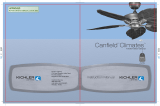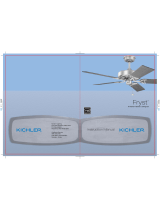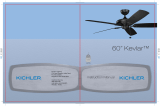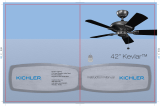Page is loading ...


1
1. SAFETY RULES
1. To reduce the risk of electric shock, insure
electricity has been turned off at the circuit
breaker or fuse box before beginning.
2. All wiring must be in accordance with the
National Electrical Code and local electrical
codes. Electrical installation should be
performed by a qualified licensed
electrician.
3. WARNING: Suitable for use with solid-
state speed controls.
4. WARNING: To reduce the risk of personal
injury, use only the two steel screws (and
lock washers) provided with the outlet box
for mounting to the outlet box. Most outlet
boxes commonly used for the support of
lighting fixtures are not acceptable for fan
support and may need to be replaced,
consult a qualified electrician if in doubt.
5. The outlet box and support structure must
be securely mounted and capable of
reliably supporting a minimum of 50
pounds. Use only CUL Listed outlet boxes
marked "FOR FAN SUPPORT".
6. The fan must be mounted with a minimum
of 7 feet clearance from the trailing edge of
the blades to the floor.
7. To operate the reverse function on this fan,
press the reverse button while the fan is
running.
8. Avoid placing objects in the path of the
blades.
9. To avoid personal injury or damage to the
fan and other items, be cautious when
working around or cleaning the fan.
10. Do not use water or detergents when
cleaning the fan or fan blades. A dry dust
cloth or lightly dampened cloth will be
suitable for most cleaning.
11. After marking electrical connections,
spliced conductors should be turned
upward and pushed carefully up into outlet
box. The wires should be spread apart with
the grounded conductor and the
equipment-grounding conductor on one
side of the outlet box.
12. Electrical diagrams are reference only.
Light kits that are not packed with the fan
must be CUL Listed and marked suitable
for use with the model fan you are
installing. Switches must be CUL General
Use Switches. Refer to the Instructions
packaged with the light kits and switches
for proper assembly.
WARNING
TO REDUCE THE RISK OF FIRE, ELECTRIC
SHOCK OR PERSONAL INJURY, MOUNT FAN TO
OUTLET BOX MARKED "ACCEPTABLE FOR FAN
SUPPORT".
WARNING
TO REDUCE THE RISK OF PERSONAL INJURY,
DO NOT BEND THE BLADE BRACKETS (ALSO
REFERRED TO AS FLANGES) DURING
ASSEMBLY OR AFTER INSTALLATION. DO NOT
INSERT OBJECTS IN THE PATH OF THE BLADES.

2
3. PACKAGE CONTENTS
Unpack your fan and check the contents. You
should have the following items:
a. Fan blades (5)
b. Hanger bracket and canopy
c. Ball/downrod assembly
d. Coupling cover
e. Fan motor assembly
f. Set of blades brackets (5)
g. Mounting plate
h. Switch housing
i. Part bag contents
1) Mounting hardware :
wood screws (2), flat washers (2),
star washers (2), wire nuts (3)
2) Blade attachment hardware:
screws (17), washers (17),
fiber washers (17)
3) Blade brackets hardware:
screws (10)
4) Safety cable hardware:
wood screw, lock washer, flat washer
5) Close mount hardware:
screw with lock washers (3)
6) Pull chain and fob
7) Balance Kit
Philips screw driver
Blade screw driver
11 mm wrench
Step ladder
Wire cutters
2. TOOLS AND MATERIALS REQUIRED
a
b
c
d
e
f
g
h
i
Canfield
TM

3
4. MOUNTING OPTIONS
If there isn't an existing UL (CUL for Canadian
Installation) listed mounting box, then read the
following instructions. Disconnect the power
by removing fuses or turning off circuit
breakers
Secure the outlet box directly to the building
structure. Use appropriate fasteners and
building materials. The outlet box and its
support must be able to fully support the
moving weight of the fan (at least 50 lbs). Do
not use plastic outlet boxes.
Figures 1,2 and 3 are examples of different
ways to mount the outlet box.
NOTE: You may need a longer downrod to
maintain proper blade clearance when
installing on a steep, sloped ceiling. (Fig. 3)
To hang your fan where there is an existing
fixture but no ceiling joist, you may need an
installation hanger bar as shown in Fig 4.
Outlet box
Provide strong
support
Recessed
outlet box
Ceiling
mounting
plate
Outlet box
Fig. 1
Fig. 3
Fig. 4
Outlet box
Fig. 2
ANGLED CEILING
MAXIMUM 20
°
ANGLE

4
Canfield
TM
Fig. 6
Fig. 7
Fig. 8
Mounting screws
(supplied with
electrical box)
Hook
Ceiling
mounting
bracket
CUL Listed
electrial
box
120V Wires
Washers
REMEMBER to turn off the power. Follow the
steps below to hang your fan properly:
Step 1. Remove the decorative canopy bottom
cover from the canopy by turning the cover
counter clockwise. (Fig. 5)
Step 2. Remove the hanger bracket from the
canopy by loosening the two screws on the
bottom of the hanging bracket. Turn the
canopy counterclockwise and remove. (Fig, 5)
Step 3. Secure the hanger bracket to the
ceiling outlet box using screws and washers
included with your outlet box. (Fig. 6)
Step 4. Remove hanger ball from downrod
assembly by loosening set screws, removing
the cross pin, and sliding ball off rod. (Fig. 7)
Step 5. Loosen the two set screws and
remove the hitch pin and lock pin from the top
coupling of the motor assembly. (Fig. 8)
Step 6. Carefully feed the fan wires up through
the downrod. Thread the downrod into the
coupling until the Hitch pin holes are aligned.
Next, replace the lock clip and hitch pin then
tighten the set screws. (Fig. 8)
Downrod
Cross pin
Hanger
ball
Set screw
Fig. 5
Hanger bracket
Ceiling
canopy
Canopy
cover
Supply wires
Downrod
Hitch pin
Lock pin
Set screws
Set screws
5. HANGING THE FAN

5
Fig. 9
Fig. 10
Registration slot
Downrod
Canopy
Canopy cover
Step 7. Slip coupling cover, canopy cover and
canopy onto downrod. Carefully reinstall
hanger ball onto rod being sure that cross pin
is in correct position, the set screw on hanger
ball is tight and wires are not twisted. (Fig. 9)
Step 8. Now lift the motor assembly into
position and place the hanger ball into the
hanger bracket. Rotate until the "Check Tab"
has dropped into the "Registration Slot" and
seats firmly. (Fig. 10). The entire motor
assembly should not rotate if this is done
correctly.
Set screws
Hitch pin
Lock pin
Coupling cover

6
Fig. 11
Fig. 12
Fig. 13
7. MAKE THE ELECTRIC CONNECTIONS
Remember to disconnect the power.
Follow the steps below to connect the fan to
your household wiring. Use the wire
connecting nuts supplied with your fan.
Secure the connectors with electrical tape.
Make sure there are no loose strands or
connections.
Step 1 Connect the fan supply (black) wire and
light supply (blue) wire to the black household
supply wire as shown in Figure 12.
Step 2. Connect the neutral fan (white) wire to
the white neutral household wire.
Step 3 Connect the fan ground wire (green) to
the household ground wire.
Step 4 After connecting the wires, spread
them apart so that the green and white wires
are on one side of the outlet box and the black
and the blue wires are on the other side.
Step 5 Turn the connecting nuts upward and
push the wiring into the outlet box.
6. INSTALLATION OF SAFETY SUPPORT
(for Canadian Installation ONLY)
Canfield
TM
Wiring
box
Ground to
mounting
bracket
or downrod
Power lines 120v
WH
BLUE
BLK
BLK
WH
FAN
LIGHT
BLK
BLUE
WH
WH
Light
switch
Green ground
WH
BLUE
BLK
BLK
WH
GRN
Wiring
box
Ground to
mounting
bracket
or downrod
BLUE
BLK
WH
WH
FAN
LIGHT
Power lines 120v
Green ground
An additional safety support is provided to
prevent the fan from falling fan). Place the end
of cable through the loop of ceiling support
cable. Pull as much cable through loop as
possible. Feed end of cable into clamp hole
and fi rmly tighten screw (Fig. 11). Cut off
excess safety cable. Secure the safety cable
to the ceiling joist with screw and washer.
Hanger bracket
Attach safety cable
to ceiling joist with
screw and washer

7
Fig. 14
Fig. 15
Step 1. Tuck connections neatly into ceiling
outlet box.
Step 2. Slide the canopy up to ceiling and
over the two screws on hanger bracket. Rotate
canopy clockwise, next, while holding the
canopy with one hand, slide the canopy cover
over the screws and rotate clockwise until
tight. NOTE: adjust the canopy screws as
necessary until the canopy and canopy cover
are snug. (Fig.15)
Warning: Make sure the "Check Tab" at the
bottom of the hanger bracket is properly
seated in the "Registration Slot" on the side of
the hanger ball before attaching the canopy to
the bracket. Failure to properly seat the
"Check Tab" could damage the electrical wires
when to ceiling fan blade direction is changed
while the fan is running.
Figures 13 and 14 illustrate the wiring
connections for optional wall control (The wire
color out of wall control may vary, see wall
control's installation manual for correct wire
connections.)
WARNING: TO REDUCE THE RISK OF FIRE,
ELECTRIC SHOCK, OR OTHER PERSONAL
INJURY. MOUNT FAN ONLY ON AN
OUTLET BOX OR SUPPORTING SYSTEM
MARKED ACCEPTABLE FOR FAN
SUPPORT.
Outlet box
Hanger
bracket
Canopy
Canopy cover
Screws
8. FINISHING THE INSTALLATION
GROUND TO
MOUNTING
BRACKET
OR DOWNROD
POWER LINES 120V
GREEN
GROUND
WIRING
BOX
WH
BLUE
BLK
BLK
WH
FAN
LIGHT
WH
WH
BLUE
BLK
LIGHT
FAN

8
Canfield
TM
9. ATTACHING THE FAN BLADES
Fig. 16
Fig. 17
Caution: Remove 5 rubber packing mounts
and discard before installation.
Step 1 Attach the blade to the blade bracket
using the screws, washers and fiber washers
as shown in Figure 16. Start screw into
bracket. Repeat for the two remaining screws.
Step 2 Make sure the blade is straight and
tighten each screw.
Step 3 Fasten blade assembly to motor using
"Pre-Installed" mounting screws in the blade
bracket.
10. INSTALLING THE MOUNTING PLATE
1. Remove 1 of the 3 screws from the
mounting ring and loosen the other 2 screws.
(Do not remove)
2. Place the key holes on the mounting plate
over the 2 screws previously loosened from
the mounting ring, turn mounting plate until it
locks in place at the narrow section of the key
holes. Secure by tightening the 2 screws
previously loosened and the one previously
removed. (Fig. 17)
Mounting
plate
Mounting ring
Screws
Screws
Blade
Blades bracket
Screws
Washers
Fiber
washers

9
Fig. 18
11. INSTALLING THE SWITCH HOUSING
NOTE: Before starting installation, disconnect
the power by turning off the circuit breaker or
removing the fuse at fuse box. Turning power
off using the fan switch is not sufficient to
prevent electric shock.
1. While holding the switch housing under your
fan, snap together the wire connection plugs .
2. Carefully push all wires back into the switch
housing, then install the switch housing onto
the mounting plate with 3 screws provided. Be
sure to tighten all screws. (Fig. 18)
Switch
housing
Wire connector
Screws
Mounting plate

10
Canfield
TM
Fig. 19
Fig. 20
12. OPERATING INSTRUCTIONS
Turn on the power and check the operation of
your fan. The pull chain controls the fan speed
as follows:
1. 3-speed pull chain- it controls the fan speed
as follows: 1 pull- High, 2 pulls- Medium,
3 pulls- Low, and 4 pulls- Off.
Speed settings for warm or cool weather
depend on factors such as the room size,
ceiling height, number of fans, and so on.
The slide switch controls directions: forward
(switch left) or reverse (switch right).
NOTE: Wait for fan to stop before changing
the setting of the slide switch.
Warm weather - (Forward) A downward airflow
creates a cooling effect as shown in Fig. 19.
This allows you to set your air conditioner on a
warmer setting without affecting your comfort.
Cool weather - (Reverse) An upward airflow
moves warm air off the ceiling area as shown
in Fig. 20. This allows you to set your heating
unit on a cooler setting without affecting your
comfort.

11
Problem
Fan will not start.
Fan sounds noisy.
Fan wobble.
Solution
1. Check circuit fuses or breakers.
2. Check line wire connections to the fan and switch wire connections in the
switch housing.
CAUTION: Make sure main power is off.
1. Make sure all motor housing screws are snug.
2. Make sure the screws that attach the fan blade bracket to the motor hub is
tight.
3. Make sure wire nut connections are not rubbing against each other or the
interior wall of the switch housing.
CAUTION: Make sure main power is off.
4. Allow a 24-hour "breaking-in" period. Most noise associated with a new fan
disappear during this time.
5. If using an optional light kit, make sure the screws securing the glassware are
tight. Check that the light bulb is also secure.
6. Some fan motors are sensitive to signals from solid-state variable speed
controls. If you have installed this type of control, choose and install another type
of control.
7. Make sure the upper canopy is a short distance from the ceiling. It should not
touch the ceiling.
1. Check that all blade and blade arm screws are secure.
2. Most fan wobbling problems are caused when blade levels are unequal. Check
this level by selecting a point on the ceiling above the tip of one of the blades.
Measure this distance.(Fig. 21) Rotate the fan until the next blade is positioned
for measurement. Repeat for each blade. The distance deviation should be equal
within 1/8".
3. Use the enclosed Blade Balancing Kit if the blade wobble is still noticeable.
4. If the blade wobble is still noticeable, interchanging two adjacent (side by side)
blades can redistribute the weight and possibly result in smoother operation.
WARNING: TO REDUCE THE RISK OF PERSONAL INJURY, DO NOT BEND
THE BLADE ARM WHILE INSTALLING, BALANCING THE BLADES, OR
CLEANING THE FAN. DO NOT INSERT FOREIGN OBJECTS BETWEEN
ROTATING FAN BLADES.
13. TROUBLESHOOTING
14. SPECIFICATIONS
These are approximate measures. They do not include Amps and Wattage used by the light kit.
xxx'Xx
kgs
Xx
kgs
0.54
0.44
0.26
65
44
17
215
170
95
5363.66
4111.47
2171.12
82.52
93.44
127.77
RPM
CFM CFM/W
N.W. G.W. C.F.
120
120
120
Fan Size
44"
Speed Volts
Amps
Watts
Low
Medium
High
/









